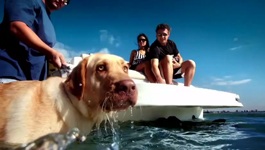Boating Lifestyle
Boating Lifestyle
There is so much to love, and learn, about boating. That's why we created this library of articles, videos and blog posts to help you throughout your adventures.
Freshwater Fishing - Natural Bait
It is important to remember never to use live bait that is not native to the area in Canada.
Have a look at some of the different boat types that are great for freshwater fishing on our boat type page!
Cut Fishing Bait
Pieces of fish, worm or other flesh are cut into chunks for bait. Popular fish to use for cut bait include gar, carp, buffalo, drum, threadfin and gizzard shad, perch and bluegill. Cut baits are impaled on 3/0 to 8/0 circle hooks.
Leeches
A hardy worm that grows over 2 inches long and lives in lakes, marshes and slow-moving streams. These parasites can be found under rocks or leaves on a lake or stream bottom. Nearly all freshwater fish dine on leeches, which are commonly used as bait for walleye.
Tips and Tricks for Leeches
Summer is the best time to fish leeches because their population is on the decline. Drift or troll a leech on a floating jighead or slip sinker rig to catch walleye. Combine a leech on a number 6 or 8 hook with a 1/8-ounce slip sinker to catch walleye.
Dough Balls
A favorite bait for carp and also effective for catfish and trout. Made from flour, cornmeal and water, the dough has cotton, oils or other substances added to toughen the bait and give it odour. Hooks featuring a spring wrapped around the shank are used to securely hold dough baits.
Grubs and Meal Worms
Ideal for panfish, sunfish and trout, these natural baits can be attached to a hook singly by threading the bait onto a hook lengthwise through the body. Threading the hook through the side of the worm or grub can add multiple baits to the hook.
Minnows
The principal natural food of many freshwater fishes, minnows can be found in ponds, lakes and streams. Two of the most common and hardiest minnows used for bait are shiners and chubs. Floating bait buckets with screen sides or holes drilled to allow water circulation are most frequently used to keep bait alive. An electric air pump is often used to keep minnows lively in a bucket or cooler.
Insects
A variety of insects make fine baits. Soft-bodied insects such as catalpa worms and caddis worms can be threaded on hooks. Tougher baits such as hellgrammites (great for smallmouth bass) are hooked through the tail or collar. Crickets and grasshoppers are also hooked through the collar or carapace.
Freshwater Clams and Mussels
Mussels inhabit lakes, ponds, rivers and creeks and are meals for catfish, perch and sunfish. After removing it from the shell, harden the mussel in the sun so it will stay on the hook longer and make it more difficult for fish to peel the bait from the hook.
Crayfish
These crustaceans stay alive a long time if kept wet and cool. Its hard shell is shed periodically; the soft-shell stage is the best time to use crayfish for bait. The tail meat is good panfish bait. Live bait cannot be used.
Cut Fishing Bait for Trolling
One of the most popular methods for catching salmon on the West Coast and the Great Lakes. Common baitfish species used for cut bait include anchovies, herring, alewives and smelt. The most prevalent form of bait is cut herring strips with meat on one side and skin on the other.
Prepared Fishing Baits
Homemade or commercially made baits used to catch catfish, bass and trout. Commercially made baits for trout include scented, floating putty and real preserved salmon eggs or egg imitations in a variety of colours. Pork rind baits for bass in various sizes and colours are made from hog skins.
Freshwater worms
A popular game fish, meal worms live in damp soil. Three types commonly used for bait are red wigglers (1 to 3 inches long), garden worms (3 to 6 inches) and nightcrawlers (up to 12 inches). Worms can be fished singly, cut into pieces or several on a hook.
Eels
A tough bait that can be used for trolling or fishing on the bottom. Eels are especially effective used whole when trolling for striped bass. An eel can be hooked through the eyes or lips when used whole. Cut them into chunks for still fishing.
For more articles on freshwater fishing and boating click here!


